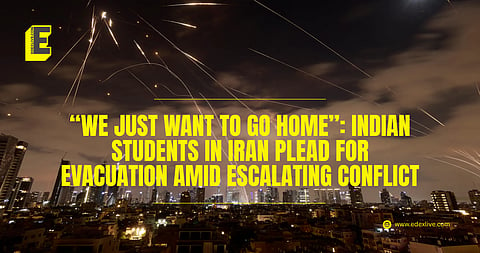

For five consecutive days, the skies over Tehran have thundered with the sounds of war. Israel's unprecedented air campaign against Iran has transformed the Iranian capital into a battleground, forcing over 1,00,000 residents to flee toward northern provinces. Among those caught in this escalating conflict are approximately 600 Indian students, predominantly medical students, whose desperate pleas for evacuation have grown increasingly urgent as the situation deteriorates.
The conflict began with Israel's surprise attack that decimated Iran's military leadership and nuclear scientists, with Israeli forces claiming control of Iranian airspace. Iran has retaliated with barrages of missiles and drones, creating a humanitarian crisis that has left civilians on both sides bearing the brunt of the violence. Iranian authorities report 224 deaths, mostly civilians, while Israel has confirmed 24 civilian casualties.
Against this backdrop of destruction, Indian students scattered across Tehran's medical universities find themselves in an increasingly precarious situation.
The Indian Embassy in Tehran has issued evacuation advisories and established 24-hour helplines, yet many students report feeling abandoned by the very institution meant to protect them.
Adeena, a student at Tehran University, describes the harrowing reality of life under bombardment. “For the past few days, we have witnessed bombings and missile strikes. We reached out to the Indian Embassy for help, and the only response we received was to 'follow social media' for updates,” she says, her frustration palpable. “Eventually, we were relocated by our university, not the embassy, to a location we can't even verify as safe. We can't disclose where we are due to security concerns.”
Her account highlights concerns about the responsiveness of institutional support on the ground. Despite repeated assurances from embassy officials that they were prepared to evacuate students if conditions worsened, concrete action has been slow to materialise.
“The helpline numbers given by the embassy either go unanswered, or the calls are cut. No one listens. This is supposed to be a professional, national institution, but the lack of accountability is shocking,” Adeena continues.
The physical and psychological toll on students is becoming increasingly evident. Confined to overcrowded shelters with up to 13 people sharing a single room, many are facing water shortages and deteriorating health conditions. “Many of us are falling sick. I personally have developed rashes all over my body since arriving at this shelter,” Adeena reveals. “Our university has at least provided us with food, but even that might not last more than two to three days.”
Mohammed Rayyan, a fourth-year medical student in Tehran, witnessed the conflict's proximity firsthand. “Just before our evacuation, a car exploded very close to the boys' dormitory. A few people sustained minor injuries,” he recounts. His university arranged buses to move students out of Tehran, but the destination's safety remains uncertain.
The disparity in evacuation efforts has become a source of additional anxiety for students. While some universities have coordinated directly with the Indian Embassy to relocate students to safer cities like Qom, others have received minimal support. “Shahid Beheshti University students were assisted directly by the Indian Embassy and relocated to Qom. Urmia University students were moved to the Armenia border through a coordinated effort between the university and the Embassy,” Rayyan explains. “In our case, the Embassy has only asked us to stay put and follow their updates on social media.”
The successful evacuation of 110 Indian students from Urmia Medical University to Armenia has provided a glimmer of hope, demonstrating that organised evacuation is possible. However, for thousands of others still in Iran, this success story only amplifies their sense of abandonment.
Syed Farwah, studying at Shahid Beheshti University of Medical Sciences, represents one of the more fortunate cases.
“We've been relocated to Qom, a city outside Tehran that is considered relatively safe at the moment. From here, we believe the next step will be to move us to Armenia, and then hopefully back to India,” she says. Yet even her optimism is tempered by uncertainty about timing and logistics.
The broader diplomatic context adds complexity to the evacuation efforts. Iran has closed its airspace due to the ongoing conflict, forcing India to explore land border crossings through Azerbaijan, Turkmenistan, and Afghanistan.
The Indian government is currently evaluating a comprehensive evacuation operation, but bureaucratic processes move slowly while bombs fall daily.
Dr Mohammad Momin Khan from the All-India Medical Students' Association acknowledges the challenges while defending the embassy's efforts. “The Indian Embassy is actively working on all fronts to ensure student safety. It's important to understand that evacuating all students at once is not feasible, but efforts are ongoing,” he explains. However, his measured tone contrasts sharply with the urgency expressed by students on the ground.
The critical role played by embassies around the world becomes clearer in times of distress. They are not just symbolic extensions of national identity but the first and often only lifeline for citizens caught in foreign crises. Yet when communication fails and action falters, the human cost can be devastating.
The incident at Tehran University of Medical Sciences, where two Indian students from Kashmir were injured in an attack near the international students' dormitory, has only intensified fears. While both students are reported to be in stable condition after being relocated, the proximity of violence to student accommodations has shattered any remaining sense of security.
As President Donald Trump's early return from the G7 summit and his public urging for Tehran residents to evacuate signal the international community's recognition of the crisis's severity, Indian students find themselves caught between escalating military action and sluggish diplomatic machinery.
The coming days will test India's commitment to its citizens abroad as the Iran-Israel conflict shows no signs of abating. For thousands of young Indians pursuing their dreams of becoming doctors, the question remains whether their government will act swiftly enough to bring them home safely, or whether they will become casualties of diplomatic inaction in a war that was never theirs to fight.
